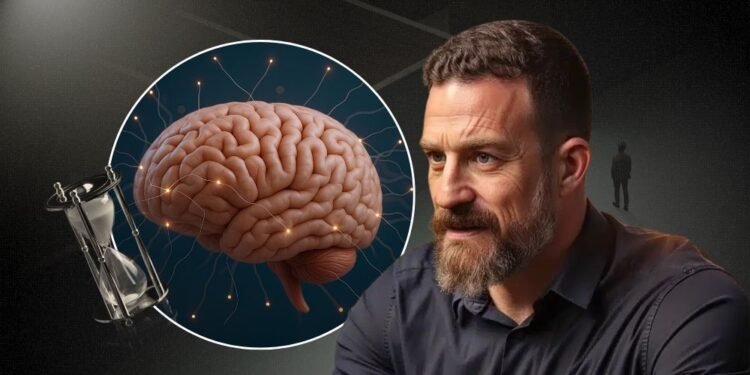Chronic procrastination is more than putting things off. Over time, it affects mental health, physical health, and productivity. About 20–25% of adults experience ongoing procrastination, with links to higher stress, depression, anxiety, and even chronic pain.
Neuroscientist Andrew Huberman points to the brain’s dopamine system as a key factor. Dopamine drives motivation and reward. When baseline dopamine is low, starting tasks feels harder, regardless of intentions. Chronic stress and avoidance behaviors deplete dopamine further, creating a feedback loop.
Huberman’s 7-step protocol addresses biology and behavior together. The goal is to restore dopamine levels and create a daily structure that reduces resistance to starting.
Step 1 – Protect your sleep architecture
Sleep is the foundation for restoring motivation. During deep sleep, dopamine receptors reset and the brain recovers from daily stress. Adults who sleep 7–9 hours maintain higher energy and focus the next day.
From earlier research, it was seen that sleep debt compounds procrastination. People who delay work often stay up late finishing it or worrying about it, which cuts into rest. Poor sleep leaves the brain under-fueled, increasing the chance of another delay cycle the following day.
Huberman recommends consistent sleep and wake times, avoiding caffeine late in the day, and reducing screen light at night. Treating sleep as “neurochemical maintenance” makes it easier to wake up ready to work.
Step 2 – Use Non-Sleep Deep Rest (NSDR)
NSDR is a structured form of deep relaxation similar to Yoga Nidra. You lie down, close your eyes, scan your body, and focus on slow breathing. This practice engages the nervous system’s recovery mode.
PET scan studies show Yoga Nidra can increase dopamine release in the striatum by up to 65%. In earlier researches, we found that even 10 minutes of NSDR during a midday slump can restore focus and reduce anxiety. This makes restarting tasks much easier without relying on caffeine.
Huberman often uses NSDR as a reset after mentally demanding work. Over time, regular sessions help maintain a more stable dopamine baseline throughout the day.
Step 3 – Get morning sunlight
Early light exposure triggers a biological chain reaction. Specialized cells in the retina signal the brain to increase dopamine and cortisol in a healthy rhythm. This improves alertness in the morning and promotes better sleep at night.
From the detailed research earlier, we saw that morning light also sets the circadian clock, making it easier to maintain steady energy levels. Huberman suggests 5–10 minutes outdoors without sunglasses, or 15–20 minutes on cloudy days. Even in winter, outdoor light is significantly more effective than indoor lighting.
Combining morning light with movement, such as a short walk, can further enhance dopamine release and improve mood for the rest of the day.
Step 4 – Eat tyrosine-rich foods
Dopamine synthesis starts with tyrosine, an amino acid obtained from food. Without enough tyrosine, the brain cannot produce dopamine efficiently.
Earlier research listed strong sources: aged cheeses like parmesan, lean meats, almonds, soy products, and avocados. Eating these foods earlier in the day supports better mental performance when you need it most.
Huberman advises focusing on balanced nutrition rather than extreme supplementation. While tyrosine supplements exist, whole foods provide additional nutrients that support brain health and avoid dopamine spikes followed by crashes.
Step 5 – Move your body daily
Movement activates neural circuits that overlap with those for motivation. Exercise raises dopamine release and increases receptor sensitivity in the brain’s reward system.
In the original research, it was found that both cardio and resistance training have lasting effects on mood and drive. Even short sessions help. Huberman recommends at least five days of activity per week, mixing different types.
A simple habit, like a 20-minute brisk walk in the morning, primes the brain for action. This “early win” effect helps break the mental barrier to starting work.
Step 6 – Break the all-or-nothing cycle
Many procrastinators delay because they expect perfect results before even starting. However, dopamine increases during progress, not only at completion.
Our earlier findings show that small wins create momentum. Writing one sentence, sending one short email, or clearing one small task can spark motivation for the next step. Huberman emphasizes lowering the entry barrier so the brain can reward action sooner.
Over time, this process rewires your mindset to associate starting with a positive chemical boost, making work feel less overwhelming.
Step 7 – Know your activation energy
Not everyone needs the same amount of effort to start a task. Brain imaging studies show “go-getters” release more dopamine in the striatum and prefrontal cortex than “slackers.”
In the earlier research, it stressed the importance of knowing your baseline. If starting feels hard, stack priming actions — like NSDR, sunlight, or movement — before tackling work. Huberman’s approach here is about designing a personalized sequence that lowers mental resistance.
This customization ensures that the dopamine boost you create is enough to cross the threshold from thinking about work to actually doing it.
Building momentum starts with one step
Breaking chronic procrastination requires consistent habits that support brain chemistry and behavior.
Applying even one of Huberman’s seven steps daily can raise dopamine levels, lower resistance, and make action feel easier. Over weeks, these small changes compound, shifting your default from avoidance to steady progress.












